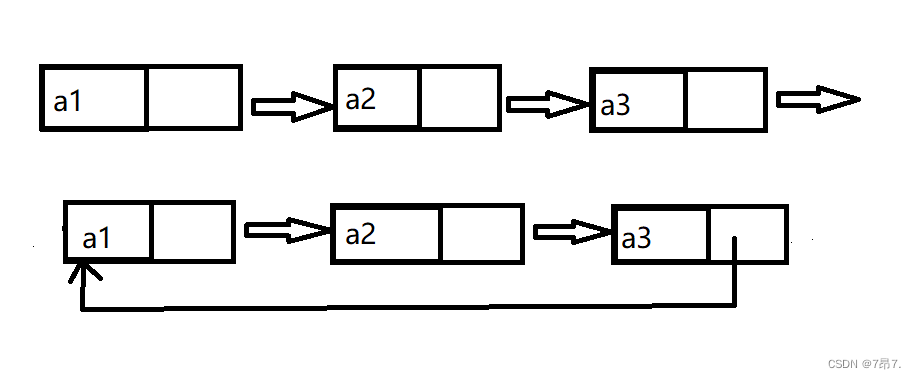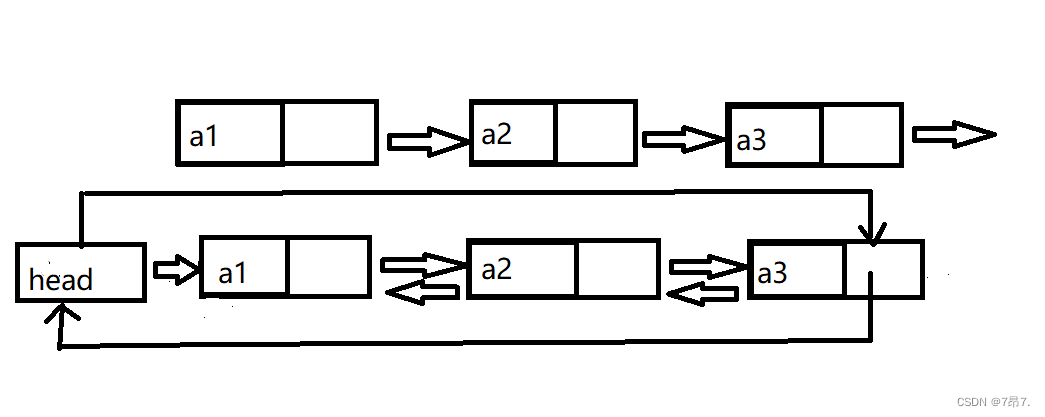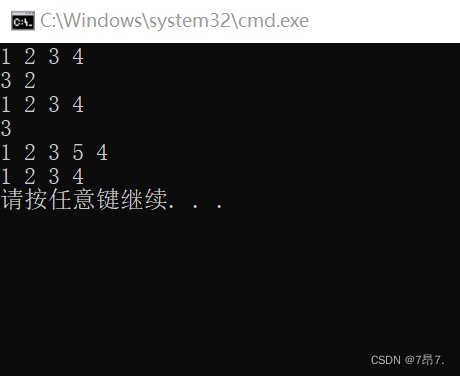文章目录
一、链表概念结构及定义
单链表是一种链式存取的,物理存储结构上非连续、非顺序的存储结构,数据元素的逻辑顺序是通过链表中的指针链接次序实现的 。链表的数据是以结点来表示,每个结点的构成是元素+指针。
元素:是存储数据的存储单元
指针:是连接每个结点的地址数据

- 从上图结构可以看到,链式结构再逻辑上是连续的,再物理上不一定连续
- 现实中的结点一般都是从堆上申请出来的
- 从堆上申请的空间,是按照一定策略来分配,两次申请的空间可能连续,也可能不连续。
C语言结构定义:
typedef int DataType//便于改类型
typedef struct Node
{
DataType data;//结点的数据域
struct Node* next;//结点的指针域
}LTNode;
二、链表分类
链表的结构非常多样,以下情况组合起来就有8种链表结构:
(1)单向或者双向:

(2)带头或者不带头:

(3)循环或者非循环:
(4)无头单向非循环和带头双向循环链表:

我们实际中最常用的是这两种结构:
1、无头单向非循环链表:结构简单,一般不会单独用来存数据。实际中更多是作为其他数据结构的子结构,如哈希桶、图的邻接表等等。
2. 带头双向循环链表:结构最复杂,一般用在单独存储数据。实际中使用的链表数据结构,都是带头双向循环链表。另外这个结构虽然结构复杂,但是使用代码实现以后会发现结构会带来很多优势,实现反而简单。
而今天实现是无头单向非循环链表
三、单链表实现逻辑
(1)创建结构体
typedef int SLTDateType;
typedef struct SListNode
{
SLTDateType data;
struct SListNode* next;
}SLTNode;
先使用typedef int SLTDateType是为了方便更改数据类型,因为链表是以结点表示的,所以在结构体里创建2个变量来表示结点SLTDateType data;
struct SListNode* next;,分别表示结点的数据域和指针域
数据域是存放数据的
指针域是存放的是下一个结点的地址
(2)具体函数实现及解析
(*)动态申请一个节点
SLTNode* BuySListNode(SLTDateType x)//动态申请节点
{
SLTNode* newnode = (SLTNode*)malloc(sizeof(SLTNode));
if (newnode == NULL)
{
perror("malloc fail");
}
newnode->data = x;
newnode->next = NULL;
return newnode;
}
动态申请结点,那函数返回的应该是一个指针类型,用malloc开辟一个SLTNode大小的空间,并用newnode指向这个空间,再判断是否为空,如为空就perror,显示错误信息。反之则把要存的数据x存到newnode指向的空间里面,把指针置为空。
(*)单链表打印
void SListPrint(SLTNode* plist)//打印链表
{
SLTNode* cur = plist;
while (cur)
{
printf("%d ", cur->data);
cur = cur->next;
}
printf("\n");
}
因为当前的指针是变化的,所以先把头指针存到定义的cur里面,在来一个while循环,终止条件是cue为空,里面是先用printf函数打印值,再更新cur。
(*)单链表尾插
void SListPushBack(SLTNode** pplist, SLTDateType x)// 单链表尾插
{
assert(pplist);
SLTNode* newnode=BuySListNode(x);
if (*pplist == NULL)
{
*pplist = newnode;
}
else
{
SLTNode* tail = *pplist;
while (tail->next)
{
tail = tail->next;
}
tail->next = newnode;
}
}
这里所用的是二级指针pplist,因为它在程序里面需要改变,这样传参传指针的地址的才能改变,而接收就要用二级指针。
尾插先用assert断言一下指针,用来检测异常情况,来提供警告信息并退出程序,再申请结点并用newnode指向,尾插有两种情况当头指针的为空,就把刚申请的结点赋给头指针,否则进行尾插尾插,先把头指针赋给定义的为指针,再用while循环来找尾部,直到为空停止,最用tail->next来链接刚申请的结点
(*)单链表的头插
void SListPushFront(SLTNode** pplist, SLTDateType x)//单链表的头插
{
assert(pplist);
SLTNode* newnode = BuySListNode(x);
newnode->next = *pplist;
*pplist=newnode;
}
头插直接就是插,不用找尾,先申请结点,再next链接头结点,即连到前面,在更新头指针,以方便下一次连接。

(*)单链表的尾删
void SListPopBack(SLTNode** pplist)//单链表的尾删
{
assert(pplist);
assert(*pplist);
if (*pplist == NULL)
{
free(*pplist);
*pplist = NULL;
}
SLTNode* tail = *pplist;
while (tail->next->next)
{
tail = tail->next;
}
free(tail->next);
tail->next = NULL;
}
尾删先找尾,如果头指针为空直接释放,并置指针为空,以防止成为野指针,再把头指针赋给定义的为指针,用while循环找尾部,用tail的下下个结点来判断,如果为空就是放下个结点,并置下个结点为空。
(*)单链表头删
void SListPopFront(SLTNode** pplist)//单链表头删
{
assert(pplist);
assert(*pplist != NULL);
SLTNode* next = (*pplist)->next;
free(*pplist);
*pplist = next;
}
先把头指针下个结点地址存放到定义的next指针里面,再释放头指针,最后更新头指针。
(*)单链表查找
SLTNode* SListFind(SLTNode* plist, SLTDateType x)// 单链表查找
{
SLTNode* cur = plist;
while (cur)
{
if (cur->data == x)
{
return cur;
}
cur = cur->next;
}
return NULL;
}
查找也是一个当前指针发生变化的过程,先把头指针存到定义的cur指针里面,再用while来查找,用if语句来判断,如果找到直接返回cur指针,没有则更新当前指针,遍历下一个。最后都没有返回空。
(*)单链表在pos位置之前插入x
void SListInsertFront(SLTNode** plist, SLTNode* pos, SLTDateType x)// 单链表在pos位置之前插入x
{
assert(plist);
assert(pos);
if (*plist == pos)
{
SListPushFront(plist, x);
}
else
{
SLTNode* pre = *plist;
while (pre->next != pos)
{
pre = pre->next;
}
SLTNode* newnode = BuySListNode(x);
pre->next=newnode;
newnode->next = pos;
}
}
在pos位置之前插入,分两种情况,第一头指针正好是pos,直接调用头插,否则进行二种情况,多个结点:先把头指针存放到定义的前驱指针pre,再用while循环来找pos,不等于pos更新pre继续找,找到之后先申请一个要插入的结点,再用前驱指针pre来链接刚申请的结点,然后申请的结点再链接pos。
(*)单链表在pos位置之后插入x
void SListInsertAfter(SLTNode * pos, SLTDateType x)//单链表在pos位置之后插入x
{
assert(pos);
SLTNode* newnode = BuySListNode(x);
SLTNode* next = pos->next;
pos->next = newnode;
newnode->next = next;
}
这个函数要结合查找函数来用。在这里面先申请结点,再把pos下个结点地址存放到next里面,再用pos来连接刚申请的结点,之后再用刚申请的结点来链接next也即是pos下一个的结点。
(*)删除pos位置之后的值
void SListEraseAfter(SLTNode* pos)//删除pos位置之后的值
{
assert(pos);
if (pos == NULL)
{
return;
}
SLTNode* del = pos->next;
pos->next = del->next;
free(del);
del = NULL;
}
先判断pos是否为空,如是则return终止函数执行,反之先把pos之后的结点地址存到del指针里面,然后直接让pos链接del的下一个结点,再释放掉中间的del。
(*)单链表删除pos位置的值
void SListErase(SLTNode** plist, SLTNode* pos)// 单链表删除pos位置的值
{
assert(plist);
assert(pos);
if (*plist == pos)
{
free(*plist);
*plist = NULL;
}
else
{
SLTNode* pre = *plist;
while (pre->next!= pos)
{
pre = pre->next;
}
pre->next = pos->next;
free(pos);
pos= NULL;
}
}
删除pos位置的值,如果头指针刚好是直接释放头指针并置为空,否则,把头指针赋给前驱指针,再用while循环找pos,找到则pre直接链接pos下一个结点,并释放掉中间的pos,并置为空。
(*)单链表的销毁
void SListDestroy(SLTNode** plist)// 单链表的销毁
{
assert(plist);
SLTNode* tail = *plist;
while (*plist)
{
while (tail)
{
tail = tail->next;
}
free(tail);
tail = NULL;
}
}
释放链表,先从尾部进行逐个删除,把头指针赋给定义的尾指针,再用两个while循环来控制,第一层是控制头指针,第二层是控制为尾指针,找到则释放并置为空,然后直到头指针为空则停止。
(3)函数对比和摒弃
我们需要摒弃 单链表在pos位置之前插入x函数和单链表删除pos位置的值函数。
原因和对比:
- 摒弃pos之前插入:因为是单向链表,需要从头遍历查找pos,如果在pos之前插入,找到pos还需要找pos之前的地址,对传参数不友好,所以一般再pos之后插入
- 摒弃删除pos位置:因为是单向链表,需要从头遍历查找pos,如果删除pos位置,找到pos还需要找pos之前的地址,对传参数不友好,而且这样就少传参数了,所以一般不删除pos,一般删除pos后面的值。
四、单链表实现代码
(1)Slist.c
#include"Slist.h"
SLTNode* BuySListNode(SLTDateType x)//动态申请节点
{
SLTNode* newnode = (SLTNode*)malloc(sizeof(SLTNode));
if (newnode == NULL)
{
perror("malloc fail");
}
newnode->data = x;
newnode->next = NULL;
return newnode;
}
void SListPrint(SLTNode* plist)//打印链表
{
SLTNode* cur = plist;
while (cur)
{
printf("%d ", cur->data);
cur = cur->next;
}
printf("\n");
}
void SListPushBack(SLTNode** pplist, SLTDateType x)// 单链表尾插
{
assert(pplist);
SLTNode* newnode=BuySListNode(x);
if (*pplist == NULL)
{
*pplist = newnode;
}
else
{
SLTNode* tail = *pplist;
while (tail->next)
{
tail = tail->next;
}
tail->next = newnode;
}
}
void SListPushFront(SLTNode** pplist, SLTDateType x)//单链表的头插
{
assert(pplist);
SLTNode* newnode = BuySListNode(x);
newnode->next = *pplist;
*pplist=newnode;
}
void SListPopBack(SLTNode** pplist)//单链表的尾删
{
assert(pplist);
assert(*pplist);
if (*pplist == NULL)
{
free(*pplist);
*pplist = NULL;
}
SLTNode* tail = *pplist;
while (tail->next->next)
{
tail = tail->next;
}
free(tail->next);
tail->next = NULL;
}
void SListPopFront(SLTNode** pplist)//单链表头删
{
assert(pplist);
assert(*pplist != NULL);
SLTNode* next = (*pplist)->next;
free(*pplist);
*pplist = next;
}
SLTNode* SListFind(SLTNode* plist, SLTDateType x)// 单链表查找
{
SLTNode* cur = plist;
while (cur)
{
if (cur->data == x)
{
return cur;
}
cur = cur->next;
}
return NULL;
}
void SListInsertFront(SLTNode** plist, SLTNode* pos, SLTDateType x)// 单链表在pos位置之前插入x
{
assert(plist);
assert(pos);
if (*plist == pos)
{
SListPushFront(plist, x);
}
else
{
SLTNode* pre = *plist;
while (pre->next != pos)
{
pre = pre->next;
}
SLTNode* newnode = BuySListNode(x);
pre->next=newnode;
newnode->next = pos;
}
}
void SListInsertAfter(SLTNode * pos, SLTDateType x)//单链表在pos位置之后插入x
{
assert(pos);
SLTNode* newnode = BuySListNode(x);
SLTNode* next = pos->next;
pos->next = newnode;
newnode->next = next;
}
void SListEraseAfter(SLTNode* pos)//删除pos位置之后的值
{
assert(pos);
if (pos == NULL)
{
return;
}
SLTNode* del = pos->next;
pos->next = del->next;
free(del);
del = NULL;
}
void SListErase(SLTNode** plist, SLTNode* pos)// 单链表删除pos位置的值
{
assert(plist);
assert(pos);
if (*plist == pos)
{
free(*plist);
*plist = NULL;
}
else
{
SLTNode* pre = *plist;
while (pre->next!= pos)
{
pre = pre->next;
}
pre->next = pos->next;
free(pos);
pos= NULL;
}
}
void SListDestroy(SLTNode** plist)// 单链表的销毁
{
assert(plist);
SLTNode* tail = *plist;
while (*plist)
{
while (tail)
{
tail = tail->next;
}
free(tail);
tail = NULL;
}
}
(2)Slist.h
#pragma once
#include<stdio.h>
#include<assert.h>
#include<stdlib.h>
typedef int SLTDateType;
typedef struct SListNode
{
SLTDateType data;
struct SListNode* next;
}SLTNode;
SLTNode* BuySListNode(SLTDateType x);// 动态申请一个节点
//SLTNode* CreateSList(int n);//创建链表
void SListPrint(SLTNode* plist); 单链表打印
void SListPushBack(SLTNode** pplist, SLTDateType x);// 单链表尾插
void SListPushFront(SLTNode** pplist, SLTDateType x);///单链表的头插
void SListPopBack(SLTNode** pplist); //单链表的尾删
void SListPopFront(SLTNode** pplist);//单链表头删
SLTNode* SListFind(SLTNode* plist, SLTDateType x);// 单链表查找
void SListInsertFront(SLTNode** plist, SLTNode* pos,SLTDateType x);// 单链表在pos位置之前插入x
void SListInsertAfter(SLTNode * pos,SLTDateType x); //单链表在pos位置之后插入x
void SListEraseAfter(SLTNode* pos);//删除pos位置之后的值
void SListErase(SLTNode** plist, SLTNode* pos);// 单链表删除pos位置的值
void SListDestroy(SLTNode* plist);// 单链表的销毁
(3)test.c
#include"Slist.h"
void test1()
{
SLTNode* plist = NULL;
SListPushBack(&plist, 1);//尾插测试
SListPushBack(&plist, 2);
SListPushBack(&plist, 3);
SListPushBack(&plist, 4);
SListPrint(plist);
}
void test2()
{
SLTNode* plist = NULL;
SListPushFront(&plist, 1);//头插+尾删+头删测试
SListPushFront(&plist, 2);
SListPushFront(&plist, 3);
SListPushFront(&plist, 4);
SListPopBack(&plist);
SListPopFront(&plist);
SListPrint(plist);
}
void test3()
{
SLTNode* plist = NULL;
SListPushBack(&plist, 1);
SListPushBack(&plist, 2);
SListPushBack(&plist, 3);
SListPushBack(&plist, 4);
SListPrint(plist);
SLTNode* ret = SListFind(plist, 3);
if (ret)
{
printf("%d\n",ret->data);
}
SLTNode* pos = SListFind(plist, 4);
if (pos)
{
SListInsertFront(&plist, pos, 5);
}
SListPrint(plist);
pos = SListFind(plist, 5);
if (pos)
{
SListErase(&plist, pos);
}
SListPrint(plist);
}
int main()
{
test1();//尾插测试
test2();//头插+尾删+头删测试
test3();//尾插+查找+在pos位置之前插入x+单链表删除pos位置的值
}
五、单链表测试结果
